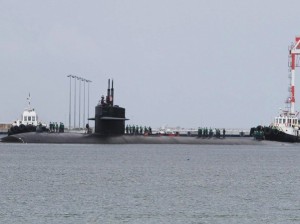
The USS Louisville arrives at Subic Bay in this June 25, 2012, file photo. Local officials and businesses in communities surrounding the Subic Bay Freeport welcomed the Department of National Defense’s plan to relocate Philippine Air Force and Navy camps to the former US naval base, in a bid to improve the country’s defense against territorial incursions by China. AP FILE PHOTO
SUBIC BAY FREEPORT, Philippines—Local officials and businesses in communities surrounding this free port welcomed the Department of National Defense’s plan to relocate Philippine Air Force and Navy camps to this former US naval base, in a bid to improve the country’s defense against territorial incursions by China.
Olongapo Mayor Rolen Paulino said the transfer “is a matter of national security.”
“If this is the plan of President Aquino, then we will support it,” he said.
Paulino said the transfer would increase the presence here of United States military personnel who are expected to take part in exercises with local troops. “And this is welcome, as it would [stimulate] the economy of Olongapo,” he said.
Defense Secretary Voltaire Gazmin told The Associated Press on Sunday that Philippine Air Force (PAF) and Philippine Navy camps would be moved to this free port to cut reaction time by fighter aircraft to the contested waters and areas in the West Philippine Sea (South China Sea).
“We’re looking now for the funding (to finance the relocation of the PAF and Navy camps),” Gazmin said.
Aurelio Pineda, spokesman of the Metro Olongapo Chamber of Commerce Inc., said the group had always taken a “positive position” on the presence of American soldiers here.
“Their presence will help in developing the local government’s tourism potential,” Pineda said, referring to military personnel from other countries who will be allowed access to military facilities here.
Olongapo used to be known as a red light district and R & R (rest and recreation) destination for American soldiers when Subic was the site of the US naval base.
The city, particularly the village of Barretto, hosts a large expatriate American community, most of them former Navy servicemen who retired here and built businesses.
Subic Bay Metropolitan Authority Chair Roberto Garcia similarly expressed hope the SBMA would benefit directly from the presence of local and foreign military troops in this economic zone.
Garcia earlier said that under the current version of the Visiting Forces Agreement, US vessels docking at the free port are not charged any fee.
“[Gazmin and I] have not yet talked about the financial arrangement [should the Air Force and Navy relocate to Subic],” he said. “There are no details yet. We haven’t had a meeting about that yet.”
Zambales Vice Gov. Ramon Lacbain II also welcomed the DND’s plan.
“That’s a most welcome development since aside from the economic uses of the former US naval base as a free port zone, it can be used now to strengthen our Navy and Air Force,” he said.
“The influx of military personnel and their economic activities will surely add to the demand for more labor, as well as for Zambales products in agriculture, fisheries and manufacturing,” he said.
In Pampanga, lawyer Arnel Casanova, president and chief executive officer of the Bases Conversion and Development Authority, said the first phase of the transfer of Air Force City from Clark to Subic will be completed before Aquino’s term expires in 2016.
Casanova said the relocation of six PAF units to Subic will free more than 300 hectares near the Clark International Airport (CRK).
PAF units have been based in Clark since 1991, after Mt. Pinatubo’s eruption. These units are the 600th Air Base Wing, 410th Maintenance Wing, 420th Supply Wing, 710th Special Operations Wing, the Air Force Logistics Command and the Air Force Reserve Command.
The PAF’s Clark Air Base Command (Cabcom) used to secure Clark Air Base until the early 1990s when the US Air Force pulled out following the volcanic eruption.
The BCDA, on the strength of Republic Act No. 7227, administers the land and waters of Clark and Subic, which span some 100,000 hectares. As former US bases, the two facilities operated together, sharing one petroleum, oil and lubricant pipeline.
Casanova said the feasibility of the CRK—as a twin airport to the Ninoy Aquino International Airport or as the major international gateway to the Philippines—would not be affected by the pullout of Air Force City.
“It is aligned with the development of CRK,” he said.—With a report from Robert Gonzaga and Tonette Orejas, Inquirer Central Luzon